If your dog has eaten packing peanuts, you may be wondering what steps to take next. While packing peanuts are not toxic to dogs, they can still have consequences if ingested. In this article, I’ll explain the potential risks of dogs eating packing peanuts and provide guidance on what you should do if your furry friend has gotten into the packaging material.
Key Takeaways:
- It’s important to take immediate action if your dog has eaten packing peanuts.
- Packing peanuts can pose a choking hazard or lead to intestinal blockage.
- Contact your veterinarian for guidance and seek prompt veterinary care.
- Consider using pet-friendly packaging alternatives to prevent future incidents.
- Pet-proof your home to keep potential hazards, including packing peanuts, out of your dog’s reach.
What Are Dissolvable Packing Peanuts?
Dissolvable packing peanuts are an eco-friendly alternative to traditional packing peanuts made from Styrofoam. These innovative packing materials are made from naturally derived starches, such as wheat and cornstarch, making them biodegradable and safe for the environment. When exposed to water, dissolvable packing peanuts dissolve completely, leaving no harmful residues behind.
While dissolvable packing peanuts are not meant to be eaten, they are generally safe for dogs. However, it’s important to note that if a dog ingests a large amount of dissolvable packing peanuts, it can potentially cause an intestinal blockage. Therefore, it’s crucial to ensure that your dog does not have access to a significant quantity of packing peanuts.
Dissolvable packing peanuts offer a more sustainable and eco-friendly solution for packaging materials. They provide effective cushioning and protection for fragile items during shipping while reducing the environmental impact. When choosing packing peanuts for your shipments, consider opting for dissolvable ones to minimize the risk to both your pet and the planet.

Table: Comparison of Dissolvable Packing Peanuts and Styrofoam Packing Peanuts
| Dissolvable Packing Peanuts | Styrofoam Packing Peanuts | |
|---|---|---|
| Material | Naturally derived starches (e.g., wheat, cornstarch) | Non-biodegradable plastic (Styrofoam) |
| Eco-Friendly | Yes | No |
| Disposal | Biodegradable, dissolves in water | Non-biodegradable, stays in the environment for centuries |
| Risk to Dogs | Potential for intestinal blockage if consumed in large quantities | Choking hazard and potential for intestinal blockage |
Symptoms of Dog Eating Dissolvable Packing Peanuts
If your dog has ingested dissolvable packing peanuts, it’s important to be aware of the potential symptoms that may indicate a problem. While dissolvable packing peanuts are generally safe for dogs, consuming a large amount can lead to gastrointestinal issues and potential blockages. Here are some common symptoms to look out for:
- Nausea: Your dog may exhibit signs of queasiness, such as excessive drooling or licking of the lips.
- Diarrhea: Loose or watery stools can indicate that your dog’s digestive system is upset.
- Vomiting: Your dog may vomit, either shortly after consuming the packing peanuts or within a few hours.
- Lack of appetite: A sudden loss of interest in food may be a sign of discomfort or gastrointestinal distress.
- Abdominal pain and swelling: Your dog may exhibit signs of discomfort, such as a tense or bloated abdomen.
- Lethargy: Reduced energy levels and increased sleepiness may indicate that something is amiss.
If you notice any of these symptoms in your dog after they have eaten dissolvable packing peanuts, it is important to consult with your veterinarian for further guidance. They will be able to assess the situation and determine the best course of action to ensure your dog’s health and well-being.

What to Do If Your Dog Ate Dissolvable Packing Peanuts?
If your dog has ingested dissolvable packing peanuts, it’s important to take immediate action to ensure their safety and well-being. While dissolvable packing peanuts are generally safe, consuming a large amount can potentially lead to intestinal blockage, which requires prompt veterinary care. Here are the steps you should follow if your dog has eaten dissolvable packing peanuts:
- Contact your veterinarian: It’s crucial to reach out to your veterinarian as soon as possible. Provide them with information about your dog’s condition and the quantity of packing peanuts consumed. They will assess the situation and provide appropriate guidance.
- Monitor your dog: Keep a close eye on your dog for any signs of distress or discomfort. Symptoms of intestinal blockage may include vomiting, diarrhea, lack of appetite, abdominal pain, and lethargy.
- Follow veterinary advice: Your veterinarian may recommend monitoring your dog closely and providing supportive care at home if the symptoms are mild. However, if the veterinarian suspects a blockage or if the symptoms worsen, they may advise bringing your dog in for an examination or performing emergency surgery to remove the packing peanuts.
“If your dog has ingested dissolvable packing peanuts, it’s important to take immediate action to ensure their safety and well-being.”
Remember, seeking veterinary care is essential to ensure your dog’s health. Your veterinarian is the best resource for providing appropriate guidance and treatment options based on your dog’s specific situation.
| Veterinary Care | Recommended Actions |
|---|---|
| Contact your veterinarian | Provide information about the situation and the quantity of packing peanuts consumed |
| Monitor your dog | Watch for symptoms of distress or discomfort |
| Follow veterinary advice | Implement recommended treatment options, which may include monitoring, supportive care, or surgical intervention |
By taking prompt action and seeking veterinary care, you can ensure the best possible outcome for your dog if they have eaten dissolvable packing peanuts. Remember to pet-proof your home, store packaging materials securely, and consider safe alternatives to prevent such incidents from happening in the future.
Types of Packing Peanuts: Biodegradable vs. Styrofoam
When it comes to packing peanuts, there are two main types to consider: biodegradable and Styrofoam. Biodegradable packing peanuts are made from plant-derived materials like cornstarch, making them a more environmentally friendly option. These peanuts are designed to break down in the environment over time, reducing their impact on landfills and ecosystems.
On the other hand, Styrofoam packing peanuts are made from non-biodegradable plastic. They do not break down naturally and can persist in the environment for hundreds of years. This poses a significant danger to wildlife and contributes to pollution. Additionally, Styrofoam packing peanuts can pose a greater risk to dogs if ingested.
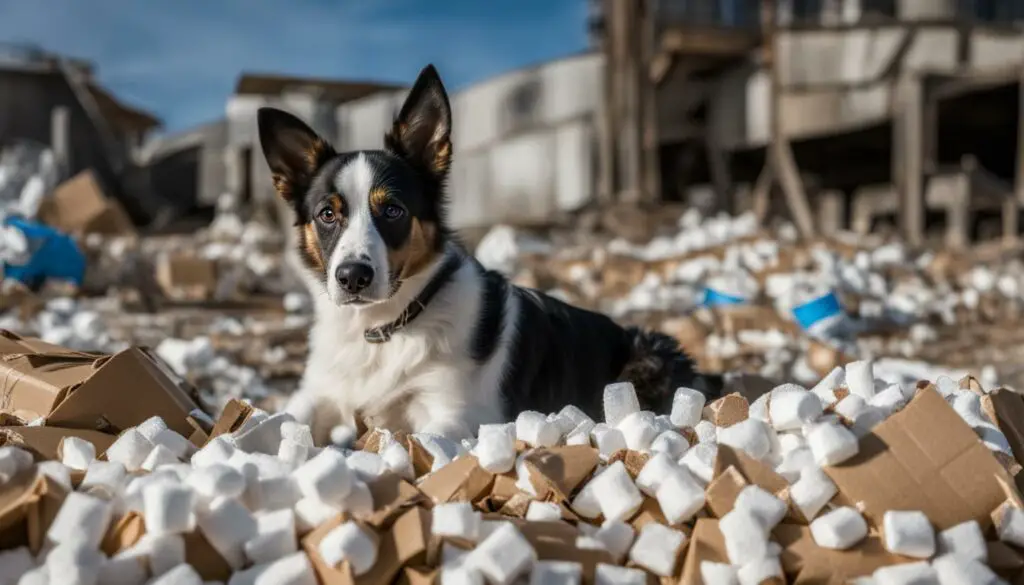
Styrofoam packing peanuts can cause choking and intestinal blockage in dogs. If a dog ingests these peanuts, it is important to seek immediate veterinary care. The risk of complications is higher with Styrofoam packing peanuts compared to their biodegradable counterparts. It is crucial to keep Styrofoam packing peanuts away from your pets to ensure their safety.
To summarize, biodegradable packing peanuts are a more environmentally friendly option, while Styrofoam packing peanuts pose a greater risk if ingested by dogs. When choosing packing materials, it is important to consider the potential impact on the environment and the safety of our furry friends.
What to Do If Your Dog Ate Biodegradable Packing Peanuts
If your dog has consumed biodegradable packing peanuts, it’s important to take appropriate steps to ensure their well-being. Although these peanuts are generally considered safe, they can still cause gastrointestinal upset, such as an upset stomach or diarrhea. Contacting a veterinarian is recommended to seek professional advice and guidance tailored to your dog’s specific situation.
When you reach out to the veterinarian, provide them with details about the incident, including the quantity of packing peanuts your dog has ingested. This information will help the veterinarian assess the situation and provide appropriate recommendations. In most cases, they may advise monitoring your dog closely for any signs of distress, such as vomiting or abdominal discomfort.
It’s essential to ensure your dog stays hydrated during this time. Offer fresh water frequently and encourage them to drink. If your dog shows any concerning symptoms, continues to have gastrointestinal upset, or if you are unsure about the severity of the situation, your veterinarian may suggest bringing your dog in for an examination.
Table: What to Do If Your Dog Ate Biodegradable Packing Peanuts
| Situation | Recommended Actions |
|---|---|
| Dog shows mild gastrointestinal upset (upset stomach, diarrhea) | Monitor closely, offer fresh water frequently, and ensure the dog stays hydrated. Contact a veterinarian for guidance. |
| Dog exhibits severe symptoms or worsening condition | Contact a veterinarian immediately and follow their instructions. They may recommend bringing the dog in for an examination. |
| Uncertainty about the severity or appropriate actions | Contact a veterinarian for professional advice tailored to your dog’s situation. |
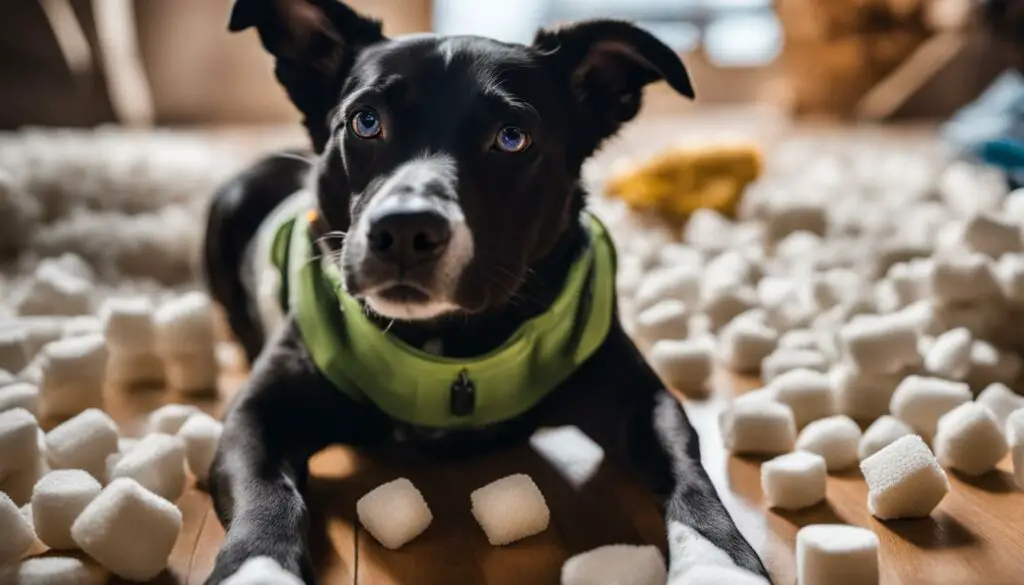
Remember, every dog is unique, and their response to ingesting packing peanuts can vary. Seeking veterinary care ensures that your dog receives proper attention and increases the likelihood of a successful recovery. While awaiting veterinary advice, keep a close eye on your furry friend and provide the necessary care and comfort they need.
What to Do If Your Dog Ate Styrofoam Packing Peanuts
If your dog has consumed Styrofoam packing peanuts, it is imperative to seek immediate veterinary care. Styrofoam is not easily digestible and can cause choking, intestinal blockage, and other health complications in dogs. Contact your veterinarian as soon as possible to discuss the situation and follow their guidance.
Your vet will assess the situation and may recommend inducing vomiting (under their guidance) or performing surgery to remove the packing peanuts from the digestive tract. They may also suggest other forms of treatment or monitoring depending on the severity of the situation. It is essential to follow their instructions carefully to ensure the best possible outcome for your dog.
Remember, time is of the essence when dealing with a potential ingestion of Styrofoam packing peanuts. Delaying or ignoring symptoms can lead to serious health consequences for your furry friend. Always prioritize their well-being and reach out to a veterinary professional for assistance.
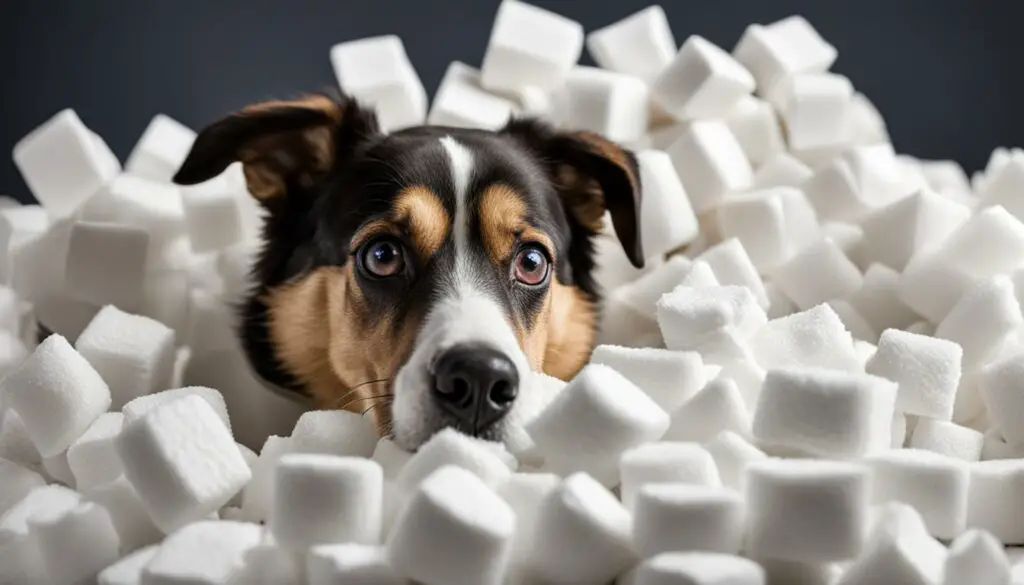
Table: Emergency Vet Care for Dogs That Ingested Packing Peanuts
| Symptoms | Actions |
|---|---|
| Choking | Seek immediate veterinary care for evaluation and potential removal of packing peanuts. |
| Intestinal blockage | Veterinarian may recommend inducing vomiting, performing surgery, or other appropriate treatments. |
| Other health complications | Follow vet’s guidance for examination, diagnosis, and treatment options. |
It’s important to note that a prompt response is necessary when dealing with a potential ingestion of Styrofoam packing peanuts. Contacting your veterinarian and seeking immediate care can help prevent further complications and increase the chances of a successful recovery for your beloved pet.
How to Prevent Dogs From Eating Packing Peanuts
Preventing dogs from eating packing peanuts is essential to ensure their safety and well-being. Here are some tips to help keep your furry friend away from these potential hazards:
1. Store packaging materials securely: Keep packages containing packing peanuts in a secure location where your dog cannot access them. Consider using sealed containers or elevated shelves to prevent any accidental ingestion.
2. Use safe alternatives: Instead of traditional packing peanuts, opt for pet-friendly packaging materials such as biodegradable packing peanuts made from plant-derived materials like cornstarch. These alternative materials are less likely to cause harm if accidentally ingested by your dog.
3. Train your dog: Teach your dog the “drop” or “leave it” command to prevent them from picking up and ingesting potential hazards. Training your dog to respond to these commands can help redirect their attention and keep them away from packing peanuts.
4. Supervise your dog: Whenever you receive a package containing packing peanuts, make sure to supervise your dog around the packaging. Keep an eye on them and intervene if they show any interest in the peanuts. Redirect their attention to safe toys or treats to distract them.
5. Pet-proof your home: Take the time to pet-proof your home by removing any potential hazards from your dog’s reach. This includes not only packing peanuts but also other small objects and toxic substances that could pose a danger to your furry friend.
By following these preventive measures, you can minimize the risk of your dog eating packing peanuts and ensure their safety. Remember, the health and well-being of your pet should always be a priority.
Table: Safe Alternatives to Packing Peanuts
| Packaging Material | Advantages |
|---|---|
| Biodegradable Packing Peanuts | – Made from plant-derived materials – Environmentally friendly – Less likely to cause harm if ingested |
| Shredded Paper | – Readily available – Can be recycled – Safe if accidentally ingested |
| Bubble Wrap | – Provides cushioning and protection – Easy to handle – Can be recycled |
| Towels | – Soft and absorbent – Can be reused – Safe if accidentally ingested |
Quote:
“Preventing dogs from eating packing peanuts is a crucial aspect of responsible pet ownership. By taking proactive measures and using safe alternatives, we can keep our furry friends safe from potential hazards.”
The Importance of Veterinary Care for Dogs That Ate Packing Peanuts
If your dog has ingested packing peanuts, it is crucial to seek veterinary care promptly. While packing peanuts are not toxic, they can still pose potential risks to your dog’s health. Choking hazards and intestinal blockages are among the possible complications that can arise from consuming packing peanuts. By consulting a veterinarian, you can ensure the well-being and safety of your furry friend.
When you bring your dog to the vet, they will assess the situation and determine the appropriate course of action. Depending on the severity of the case, the vet may recommend close monitoring for any signs of distress or perform further examinations to check for blockages. In more severe instances, emergency surgery may be necessary to remove the blockage or retrieve the packing peanuts from the stomach.
Early veterinary intervention is crucial because delaying or avoiding care can lead to worsened symptoms and potentially life-threatening complications. Seeking professional help increases the likelihood of a successful recovery and minimizes the potential risks associated with ingesting packing peanuts.
Remember, even if your dog seems fine initially, it is still essential to consult a veterinarian. Some symptoms may not appear immediately, and by the time they do, the condition could have worsened. Prioritizing your dog’s health by seeking veterinary care promptly is the best approach when it comes to the ingestion of packing peanuts.
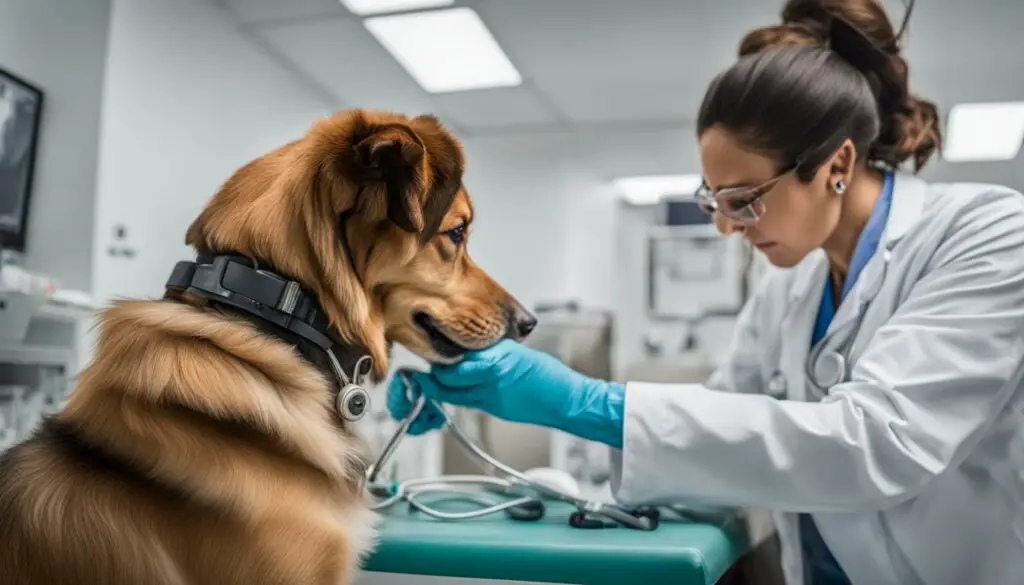
Safe Alternatives to Packing Peanuts for Dogs
If you’re concerned about the potential risks of traditional packing peanuts for your dog, there are several safe alternatives you can consider. These alternatives provide cushioning and protection for your items during shipping while minimizing the risk of harm if accidentally ingested by your furry friend.
Biodegradable Packing Peanuts
One safe alternative to traditional packing peanuts is biodegradable packing peanuts made from plant-derived materials like cornstarch. These packing peanuts break down naturally in the environment, reducing their impact on the planet and posing less risk to dogs if ingested. They provide effective cushioning and protection for your items while offering peace of mind for pet owners.
Shredded Paper or Newspaper
Another pet-friendly option is to use shredded paper or newspaper as packing material. Simply tear or shred old newspapers or unwanted paper into small pieces and use them to fill the gaps and protect your items. This alternative is inexpensive, readily available, and safe for dogs if accidentally consumed.
Bubble Wrap or Towels
Bubble wrap or towels can also serve as safe alternatives to packing peanuts. Bubble wrap provides cushioning while towels can be used to wrap fragile items. Both options offer protection during shipping and are less likely to pose a risk if ingested by your furry friend. Just be sure to secure the bubble wrap or towels properly to prevent your dog from tearing or chewing on them.
By choosing these pet-friendly packaging alternatives, you can ensure the safety and well-being of your dog while still protecting your items during shipping. Remember to keep packing peanuts and other potential hazards out of your pet’s reach and maintain a pet-proofed home to prevent any accidents or mishaps.
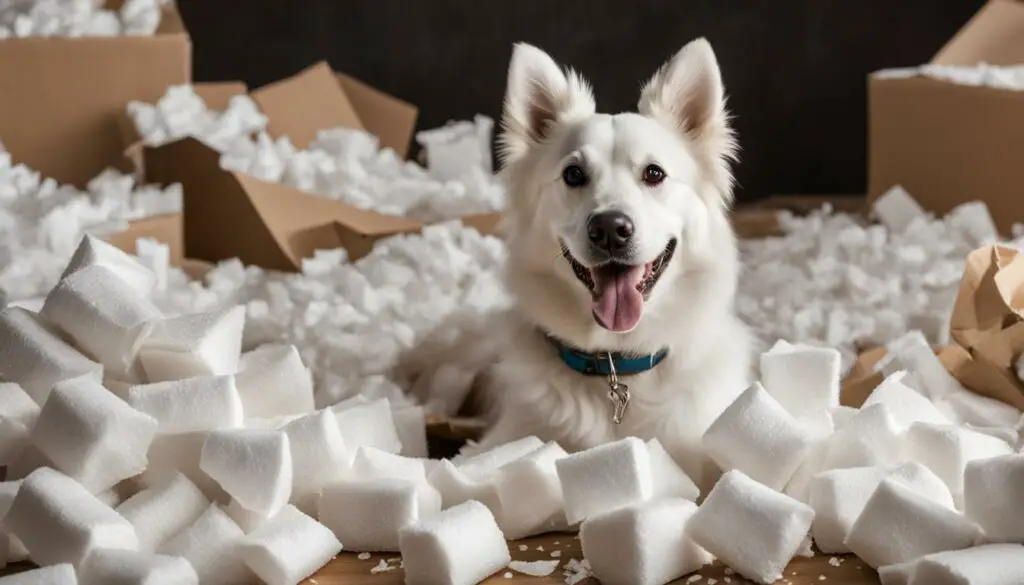
Table: Comparison of Safe Alternatives to Packing Peanuts for Dogs
| Safe Alternatives | Advantages | Disadvantages |
|---|---|---|
| Biodegradable Packing Peanuts | – Made from plant-derived materials – Breaks down naturally – Less risk if ingested |
– May not provide as much cushioning as traditional packing peanuts |
| Shredded Paper or Newspaper | – Inexpensive and readily available – Safe if accidentally consumed |
– May not offer as much protection for fragile items |
| Bubble Wrap or Towels | – Provides cushioning and protection – Bubble wrap can be reused – Towels are versatile |
– Bubble wrap can be noisy and may not be suitable for all items – Towels may require extra space for larger items |
The Importance of Pet-Proofing Your Home
Pet-proofing your home is crucial to ensure the safety and well-being of your furry friends. Dogs, in particular, have a curious nature and can easily get into trouble if they come across potential hazards. By taking proactive measures to pet-proof your home, you can create a safe environment where your pets can thrive and avoid unnecessary accidents or illnesses.
One of the first steps in pet-proofing your home is to keep packing peanuts, as well as other potentially harmful items, out of your pets’ reach. These small, lightweight materials can pose a choking hazard if ingested by your pets. Ensure that packages containing packing peanuts are stored securely in a location where your pets cannot access them, such as a locked cabinet or high shelf.
In addition to packing peanuts, it’s important to identify and eliminate any other hazards that may be present in your home. This can include toxic plants, household chemicals, loose electrical cords, and small objects that your pets could swallow. Keep these items in areas that are inaccessible to your pets or use childproof locks to secure cabinets and drawers.
Furthermore, consider using safe and pet-friendly alternatives to traditional packaging materials. Biodegradable packing peanuts made from plant-derived materials are a more environmentally friendly option that poses less risk to your pets if accidentally ingested. Other alternatives such as shredded paper, bubble wrap, or towels can provide cushioning and protection for your items during shipping without posing a danger to your furry companions.
Creating a Pet-Friendly Environment
In addition to removing hazards, it’s important to create a pet-friendly environment that encourages positive behaviors and reduces the chances of accidents or incidents. Provide plenty of toys and interactive activities to keep your pets mentally stimulated and prevent them from engaging in destructive behaviors. Establish designated areas for your pets to eat, sleep, and play, ensuring they have their own space within your home.
Regularly inspect your home for any potential dangers and make adjustments accordingly. Keep in mind that what may seem harmless to you could pose a risk to your pets. Consulting with your veterinarian can also provide valuable insights and guidance on pet-proofing your home.
| Hazards to Avoid | Pet-Friendly Alternatives |
|---|---|
| Chemical cleaners | Natural, pet-safe cleaning products |
| Toxic plants | Non-toxic plants or artificial plants |
| Loose electrical cords | Cord covers or keeping cords out of reach |
| Small objects | Keep small objects out of pets’ reach |
By pet-proofing your home and being proactive in identifying and eliminating potential hazards, you can ensure the safety and well-being of your beloved pets. Remember to provide a pet-friendly environment with plenty of enriching activities and consult with your veterinarian for additional guidance. With these measures in place, you can enjoy a harmonious and safe living space for both you and your furry companions.

Conclusion
In conclusion, if your dog has eaten packing peanuts, it is crucial to take immediate action to ensure their health and safety. While dissolvable packing peanuts are generally safe, they can still cause gastrointestinal upset. On the other hand, Styrofoam packing peanuts pose a greater risk of choking and intestinal blockage.
To protect your dog from potential harm, it is essential to pet-proof your home by keeping packing peanuts and other hazards out of their reach. Store packaging materials securely and consider using safe alternatives such as biodegradable packing peanuts or shredded paper.
If your dog does ingest packing peanuts, it is important to seek veterinary care promptly. While packing peanuts are not toxic, they can still cause significant health problems. A veterinarian can assess the situation, provide appropriate treatment, and ensure your dog’s well-being.
By taking these precautions and seeking prompt veterinary care, you can help prevent the consequences of your dog eating packing peanuts and ensure a safe and pet-friendly environment for your furry friend.
FAQ
Are dissolvable packing peanuts safe for dogs?
Dissolvable packing peanuts are generally safe for dogs. However, if a dog ingests a large amount, it can potentially cause an intestinal blockage. It’s important to monitor your dog closely and contact your veterinarian for guidance if they have eaten dissolvable packing peanuts.
What are the symptoms if my dog eats dissolvable packing peanuts?
Symptoms of a dog eating dissolvable packing peanuts may include nausea, diarrhea, vomiting, lack of appetite, abdominal pain and swelling, and lethargy. These symptoms could indicate an intestinal blockage and require veterinary attention.
What should I do if my dog ate dissolvable packing peanuts?
If your dog has eaten dissolvable packing peanuts, it’s best to contact your veterinarian for guidance. They will assess the situation and may recommend monitoring your dog closely or performing an examination to check for blockages. In severe cases, emergency surgery may be required.
What are the risks of dogs eating Styrofoam packing peanuts?
Styrofoam packing peanuts are not easily digestible and can cause choking, intestinal blockage, and other health complications in dogs. If your dog has consumed Styrofoam packing peanuts, immediate veterinary care is necessary.
What should I do if my dog ate biodegradable packing peanuts?
While biodegradable packing peanuts are generally considered safe, they can still cause gastrointestinal upset. Contact your veterinarian for advice and monitor your dog closely. If symptoms persist or worsen, bring your dog in for an examination.
How can I prevent my dog from eating packing peanuts?
To prevent dogs from eating packing peanuts, store packages containing them in a secure location out of their reach. Consider using alternative packaging materials, such as biodegradable packing peanuts or shredded paper. Additionally, train your dog to drop or leave items on command to prevent ingesting potential hazards.
Why is veterinary care important if my dog ate packing peanuts?
Veterinary care is crucial for dogs that have eaten packing peanuts to ensure their well-being. Even though packing peanuts are not toxic, they can still cause significant health problems such as choking, intestinal blockage, and gastrointestinal upset. Seeking immediate veterinary care increases the chances of a successful recovery.
What are some safe alternatives to packing peanuts for dogs?
Safe alternatives to packing peanuts for dogs include biodegradable packing peanuts made from plant-derived materials, shredded paper, bubble wrap, or towels for cushioning items during shipping. These materials are less likely to cause harm if accidentally ingested.
Why is pet-proofing my home important?
Pet-proofing your home is essential to ensure the safety of your furry friends. This includes keeping packing peanuts and other potential hazards out of their reach. Store packaging materials securely, use pet-friendly packaging alternatives, and regularly check your home for any potential hazards that could harm your pets.






